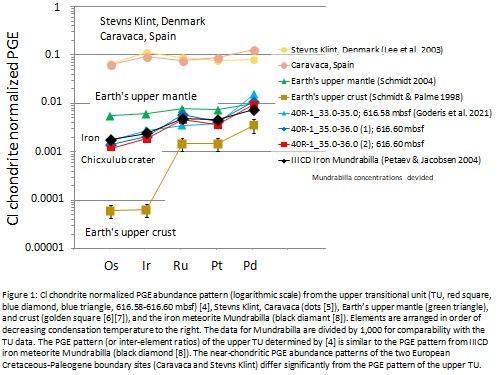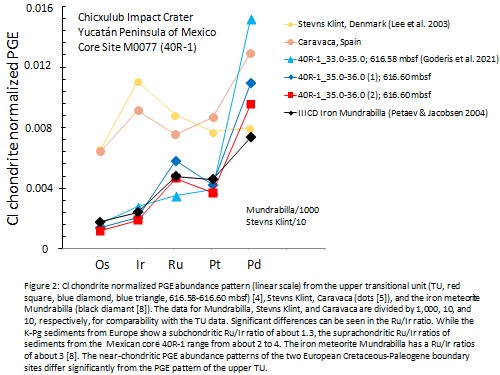Chicxulub impact crater data from the Yucatán Peninsula in Mexico re-interpreted: evidence for an iron meteoritic asteroid as impactor
- 64625 Bensheim, Germany
1. Introduction
The Cretaceous-Paleogene (K-Pg) mass extinction is marked globally by elevated concentrations of the platinum group elements (PGE), emplaced by a impact event 66.051 ± 0.031 Ma ago [1][2]. The 180- to 200-km-wide Chicxulub impact structure on the Yucatán Peninsula [3] is being considered as a possible impact crater that led to the global enrichment of PGE at the K-Pg boundary. The PGE signature (data from [4]) in the gray-green marlstone interval of Core 40R-1 recovered from Site M0077 on the Chicxulub peak ring in the Gulf of Mexico is distinctly different from a meteoritic component consistent with a chondritic impactor as well as the near-chondritic PGE abundance pattern at the European K-Pg boundary sites of Caravaca in Spain and Stevns Klint in Denmark.
2. Non-chondritic PGE abundance pattern at the Chicxulub impact structure
The PGE pattern (or inter-element ratios) from the upper transitional unit (TU; 616.58-616.60 mbsf) [4], Stevns Klint, Caravaca [5], Earth’s upper mantle, and crust [6][7], and the iron meteorite Mundrabilla [8] are shown in Figure 1. Unfortunately Rh was not determined. Significant differences can be seen, for example, in the Ru/Ir ratio (Table 1).
While the K-Pg sediments from Europe show a subchondritic Ru/Ir ratio of about 1.3, the suprachondritic Ru/Ir ratios of sediments from core 40R-1 range from about 2 to 4 (Figures 1-4).


The Ru/Ir ratio of about 4 was measured on two subsamples from a depth of 616.6 mbsf at the University of Tokyo in Komaba using a Thermo Element XR HR-ICP-MS. The Ru/Ir ratio of about 2 was measured by ID-MS on one sample (616.58 mbsf) at the Vrije Universiteit Brussel [4]. The iron meteorites Mundrabilla and Duchesne have Ru/Ir ratios of about 3 and 5, respectively [8].
The signature of the upper TU from the drill core is similar to the PGE pattern from the irons Mundrabilla and Duchesne (Figure 4). This observation calls into question the Chicxulub impact structure as the source crater for the near-chondritic PGE ratios in European K-Pg boundary sites. The non-chondritic PGE ratios of the upper TU are evidence that the globally distributed iridium layer is not preserved in the Chicxulub impact structure. The most likely source for the PGEs in the upper TU of core 40R-1 sediments are Mundrabilla and Duchesne like iron impactors.
3. Future studies
The Ru isotope composition could be used as a powerful analytical tool alongside PGE ratios (especially the diagnostic Ru/Rh and Ir/Rh mass ratios [9]) to identify impactor signatures [10].
4. Conclusion
It seems to have been different projectile types and different temporal events [11][12], that left the near-chondritic PGE abundance patterns in Europe and the iron meteoritic abundance pattern in the sediments of the Chicxulub impact crater. When talking about synchronicity, it is easily overlooked that enormous time spans of ±31 ka (uncertainties) are meant for events that took place about 66 Ma ago. However, relative dating of individual events and their correlation is possible with lithostratigraphy and biostratigraphy and can be supplemented, but not replaced, by radioisotope dating.
References
[1] Alvarez L. W., Alvarez W., Asaro F. & Michel H. V. (1980) Extraterrestrial cause for the Cretaceous-Tertiary extinction. Science 208, 1095 - 1108.
[2] Renne P. R., Arenillas I., Arz J. A., Vajda V., Gilabert V. & Bermúdez H. D. (2018) Multi-proxy record of the Chicxulub impact at the Cretaceous-Paleogene boundary from Gorgonilla Island, Colombia. Geology 46, 547 - 550.
[3] Hildebrand A. R., Penfield G. T., Kring D. A., Pilkingston M., Camargo Z. A., Jacobsen S. B. & Boynton W. V. (1991) Chicxulub Crater: A possible Cretaceous/Tertiary boundary impact crater on the Yucatán Peninsula, Mexico. Geology 19, 867 - 871.
[4] Goderis S., Sato H., Ferrière L., Schmitz B., Burney D., Kaskes P., Vellekoop J., Wittmann A., Schulz T., Chernonozhkin S. M., Claeys P., de Graaff S. J., Déhais T., de Winter N. J., Elfman M., Feignon J.-G., Ishikawa A., Koeberl C., Kristiansson P., Neal C. R., Owens J. D., Schmieder M., Sinnesael M., Vanhaecke F., Van Malderen S. J. M., Bralower T. J., Gulick S. P. S., Kring D. A., Lowery C. M., Morgan J. V., Smit J., Whalen M. T. & IODP-ICDP Expedition 364 Scientists (2021) Globally distributed iridium layer preserved within the Chicxulub impact structure. Science Advances 7, eabe3647.
[5] Lee C.-T. A., Wasserburg G.J. & Kyte F. (2003) Platinum-group elements (PGE) and rhenium in marine sediments across the Cretaceous–Tertiary boundary: Constraints on Re-PGE transport in the marine environment. Geochimica et Cosmochimica Acta 67, 655 - 670.
[6] Schmidt G. (2004) Are high-temperature fractionations in the solar nebula preserved in highly siderophile element systematics of the Earth’s mantle? Meteoritics & Planetary Science 39, 1995 - 2007.
[7] Schmidt G. & Palme H. (1998) The concentrations of highly siderophile elements in Earth's upper crust as inferred from the compositions of large terrestrial impact melt sheets. 29th Lunar and Planetary Science Conference, Abstract #1273
[8] Petaev M.I. & Jacobsen S.B. (2004) Differentiation of metal‐rich meteoritic parent bodies: I. Measurements of PGEs, Re, Mo, W, and Au in meteoritic Fe‐Ni metal. Meteoritics & Planetary Science 39, 1685 - 1697.
[9] Schmidt G. (2019) Ru/Rh and Ir/Rh as diagnostic mass ratios for the identification of specific impactor compositions of terrestrial impact craters. Paneth Kolloquium, Nördlingen (Germany), Abstract #0009
[10] Schmidt G. (2019) Distinguishing different types of projectiles from terrestrial impact craters – Clearwater East (Canada) and Rochechouart (France) re-investigated. Large Meteorite Impacts and Planetary Evolution VI, Lunar and Planetary Institute Contribution No. 2136, Abstract #5006.
[11] Keller G., Stinnesbeck W., Adatte T. & Stüben D. (2003) Multiple impacts across the Cretaceous–Tertiary boundary. Earth-Science Reviews 62, 327 - 363.
[12] Keller G. (2005) Impacts, volcanism and mass extinction: Random coincidence or cause and effect? Australian Journal of Earth Sciences 52, 725 - 757.
How to cite: Schmidt, G.: Chicxulub impact crater data from the Yucatán Peninsula in Mexico re-interpreted: evidence for an iron meteoritic asteroid as impactor, European Planetary Science Congress 2021, online, 13–24 Sep 2021, EPSC2021-49, https://doi.org/10.5194/epsc2021-49, 2021.

